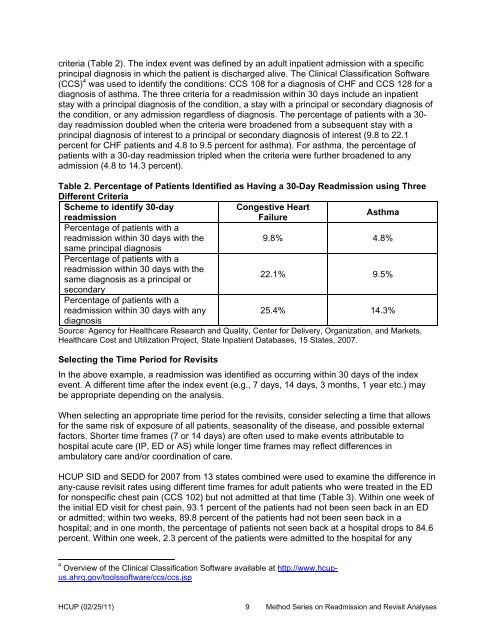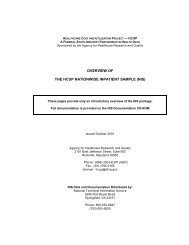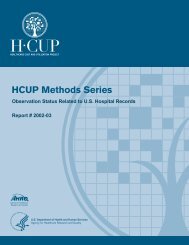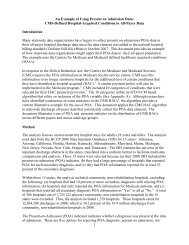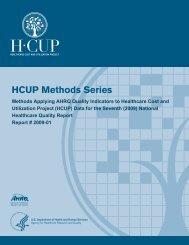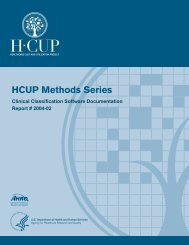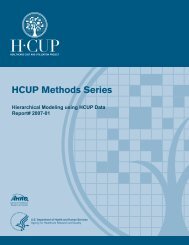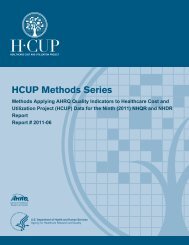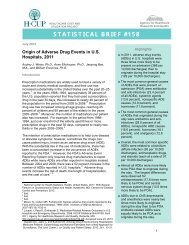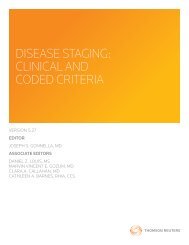Methodological Issues when Studying Readmissions and ... - HCUP
Methodological Issues when Studying Readmissions and ... - HCUP
Methodological Issues when Studying Readmissions and ... - HCUP
You also want an ePaper? Increase the reach of your titles
YUMPU automatically turns print PDFs into web optimized ePapers that Google loves.
criteria (Table 2). The index event was defined by an adult inpatient admission with a specificprincipal diagnosis in which the patient is discharged alive. The Clinical Classification Software(CCS) 4 was used to identify the conditions: CCS 108 for a diagnosis of CHF <strong>and</strong> CCS 128 for adiagnosis of asthma. The three criteria for a readmission within 30 days include an inpatientstay with a principal diagnosis of the condition, a stay with a principal or secondary diagnosis ofthe condition, or any admission regardless of diagnosis. The percentage of patients with a 30-day readmission doubled <strong>when</strong> the criteria were broadened from a subsequent stay with aprincipal diagnosis of interest to a principal or secondary diagnosis of interest (9.8 to 22.1percent for CHF patients <strong>and</strong> 4.8 to 9.5 percent for asthma). For asthma, the percentage ofpatients with a 30-day readmission tripled <strong>when</strong> the criteria were further broadened to anyadmission (4.8 to 14.3 percent).Table 2. Percentage of Patients Identified as Having a 30-Day Readmission using ThreeDifferent CriteriaScheme to identify 30-dayCongestive HeartreadmissionFailureAsthmaPercentage of patients with areadmission within 30 days with the9.8% 4.8%same principal diagnosisPercentage of patients with areadmission within 30 days with thesame diagnosis as a principal or22.1% 9.5%secondaryPercentage of patients with areadmission within 30 days with any25.4% 14.3%diagnosisSource: Agency for Healthcare Research <strong>and</strong> Quality, Center for Delivery, Organization, <strong>and</strong> Markets,Healthcare Cost <strong>and</strong> Utilization Project, State Inpatient Databases, 15 States, 2007.Selecting the Time Period for RevisitsIn the above example, a readmission was identified as occurring within 30 days of the indexevent. A different time after the index event (e.g., 7 days, 14 days, 3 months, 1 year etc.) maybe appropriate depending on the analysis.When selecting an appropriate time period for the revisits, consider selecting a time that allowsfor the same risk of exposure of all patients, seasonality of the disease, <strong>and</strong> possible externalfactors. Shorter time frames (7 or 14 days) are often used to make events attributable tohospital acute care (IP, ED or AS) while longer time frames may reflect differences inambulatory care <strong>and</strong>/or coordination of care.<strong>HCUP</strong> SID <strong>and</strong> SEDD for 2007 from 13 states combined were used to examine the difference inany-cause revisit rates using different time frames for adult patients who were treated in the EDfor nonspecific chest pain (CCS 102) but not admitted at that time (Table 3). Within one week ofthe initial ED visit for chest pain, 93.1 percent of the patients had not been seen back in an EDor admitted; within two weeks, 89.8 percent of the patients had not been seen back in ahospital; <strong>and</strong> in one month, the percentage of patients not seen back at a hospital drops to 84.6percent. Within one week, 2.3 percent of the patients were admitted to the hospital for any4 Overview of the Clinical Classification Software available at http://www.hcupus.ahrq.gov/toolssoftware/ccs/ccs.jsp<strong>HCUP</strong> (02/25/11)9Method Series on Readmission <strong>and</strong> Revisit Analyses


